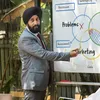How to break free from the endless pursuit of meetings
Is it FOMO, the pressure to be available at any time, or is it the global distribution of teams causing this behaviour? Here are a few techniques to ensure we are breaking free of the endless pursuit of meetings.
Meetathon: The marathon of back to back meetings, tiring all, and eventually, adding low value.
The COVID-19 pandemic altered our entire way of living. The debate is about whether it has positively or negatively influenced our lives.
There are different schools of thought on whether the pandemic and remote working have enriched our lifestyle, given there is no travel, and we have more time for ourselves and family.
The contrarian view is that we were sucked into the bottomless pit of work and family 24/7, without a break, and any semblance of boundaries are non-existent.
Last year, when we started work from home, we were just getting used to the new normal. We slowly transitioned into the virtual mode of working.
After 18 months, it seems like meetings and the virtual world may have engulfed and enslaved us. Running back-to-back meetings to responding to emails to IM’s to different channels on different collaboration tools has gotten us entangled in a vicious cycle.
We have all tried different techniques and ideas to beat this cycle, but reluctantly succumb to the addiction for meetings. Is it FOMO, the pressure to be available at any time, or the global distribution of teams causing this behaviour?
Here are a few techniques to ensure we are breaking free of this endless pursuit of meetings:
Agenda is king
Is the agenda of the meeting called out? Are roles and responsibilities clearly defined, and has the desired outcome been established? If not, please ask the meeting organiser to be clear on these or help them carve it out.
Heads-up on the topic aka, pre-read
I have seen two extremes. One, where a large group of attendees join and they are introduced to the topic for the first time — you can imagine nothing much gets done. The other extreme is pre-read, which persuades the participants to come prepared. Do a good pre-read with clear action items, and give three to four days of advance notice.
Must have or nice to have
Is the meeting needed? Is it urgent, and do team members need to be in face-to-face mode?
Many times when you raise this often-ignored question, the organiser finds creative ways to get the objectives done without assembling a large audience for a set time.
Are you needed?
If each one of us poses this question to ourselves and others, you will realise that a lot of folks are not needed in the meeting. A few might need to be made aware of the outcome, and can be achieved by forwarding them the minutes-of-the-meeting. I would highly recommend the usage of optional attendees.
ALSO READ

End the meeting, if done
Earlier, when we only had a few conference calls, it was fun to speak of the weather, sports, and everything under the sun.
Now that these calls are very frequent, it might be a good idea to tone this down and end the meeting early if the agenda items are done. Returning time to your colleagues is the best gift you can give them today.
Small drops count
Another small, yet very powerful fix is setting the meeting to start or end five minutes early for 30-minute calls, and 10 minutes for 60-minute calls. This may seem like a small step, but it plays a significant role in helping one clear one’s head and getting refreshed before the next call.
Asynchronous communication is the way
Several objectives of a meeting can be broken down and solved via asynchronous communication modes — be it team channels, group chats, or a short phone call.
It also works beautifully for globally distributed teams to respond when they are back and ready to support that conversation.
Action items can be tracked and discussed in the meeting chat, thereby avoiding the need for a meeting just to have another meeting about another meeting.
Right decision-makers
Empowering team members to be decision-makers, who are aware of what needs to be communicated, can reduce the need for several folks to be on at the same time.
Technology to your aid
Most modern communication tools such as Outlook and Microsoft Teams provide excellent analytics and track behavioural patterns of the user.
Use it to your advantage and periodically review the action items and recommendations, and you will start seeing a positive change.
Set aside time
Block out periods in the day for learning, other strategic-thinking efforts, and lunch. I have seen a few folks creatively use the virtual commute feature on MS Teams.
I am sure that the usage of a few of these tips will help you have more time for yourself and your loved ones. This extra time can also help invigorate your thinking, sharpen your creativity, and make WFH and the associated meetings more sustainable.
You should own your time and calendar — no hijacking others’ time. Every meeting must be thought through and should have value derived from it. Voice out concerns on repetitive non-productive meetings.
Edited by Suman Singh
(Disclaimer: The views and opinions expressed in this article are those of the author and do not necessarily reflect the views of YourStory.)







